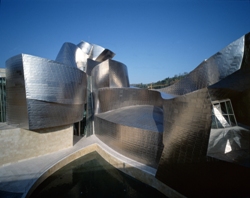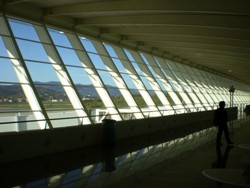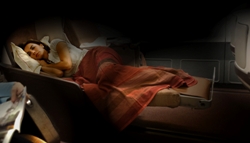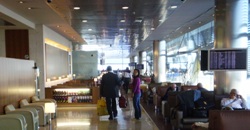by Ron Bernthal

The Guggenheim-Bilbao Museum, designed by Frank Gehry, opened in 1997, and has been the catalyst for Bilbao’s revitalization. (photo: Guggenheim Museum)
Bilbao, Spain, home of the stunning Guggenheim Museum and a number of other famously designed buildings and urban structures, is within easy reach of the U.S. East Coast with Iberia’s daily non-stop flight to Madrid-Barajas (MAD), and the short connecting flight to Bilbao (BIO), the largest city in the Basque region of Spain.
Leaving Bilbao recently on the return trip to New York I boarded the Bilbao Airport shuttle bus at Plaza Moyua, a lovely, circular park in the center of the city. The shuttle bus stops at the front of the historic Carlton Hotel, and within a few meters of Metro Bilbao’s Plaza Moyua station, with its landmark Norman Foster-designed glass entrance.

Bilbao’s Moyua Plaza, with Norman Foster-designed Metro entrances in center and left of photo. (photo: Nigel Young, Foster + Partners)
Bilbao Airport itself is an architectural masterpiece, designed in 2000 by the noted Spanish architect Santiago Calatrava. The terminal has a sleek design, with two symmetrical white concrete “wings,” and has been nicknamed “La Paloma,” (The Dove). The soaring pointed tip at the center of the terminal creates an open and luminous interior space where check-in counters are located, and arriving passengers can feel as if they are entering a post-modern church, with light streaming into the building from an array of upper level windows.
Calatrava also designed Bilbao’s Zubizuri Bridge, using his typical white concrete materials and sleek curves to create a lovely pedestrian bridge over the Nervion River near the Guggenheim Museum. Tourists often linger on the bridge, standing on its glass-brick walkway as they take photos of the bridge’s ethereal white suspension wires, and the glittering, silvery skin of the nearby museum.
After checking in for my flight to Madrid at Bilbao Airport I made my way to Iberia’s VIP Lounge, possibly the most beautiful airport lounge I have visited. Although the airport is small, designed to move about 4 million passengers a year, compared to 40 million at Madrid-Barajas, the Iberia VIP Lounge is nicely outfitted with modern wood furniture, comfortable couches, several Internet terminals, a self-service snack bar and beverage cooler. Floor to ceiling slanted windows provide natural light and a view of the tarmac. It was a pleasure waiting for my flight in such a welcoming and comfortable setting.

Interior windows of Bilbao Airport, designed by Santiago Calatrava. (photo: Ron Bernthal)
I walked to my gate about 30 minutes prior to my 1:35 pm flight, only to find a long line of passengers waiting to board. There was no separate Business Plus line, which I found somewhat disconcerting since I had to wait at the end of the line until all passengers had boarded. The A319 aircraft, configured 3-3, with 44 seats in Business, 60 in Economy, was full, and I settled into 2A for the one hour flight to Madrid.
Our departure pattern carried us westward, following the Nervion River valley to the Bay of Biscay, and from my window seat I could follow the historic urbanization scheme of Bilbao, with former steel plants and shipbuilding yards lining the river, mirroring Bilbao’s expansion as an inland ocean port. Turning south we overflew the mountain ridges of northern Spain, many with wind turbines along the top looking like white zipper lines across the green plateaus. The dry, desert-like terrain of central Spain came into view before our landing at Madrid-Barajas, a few minutes ahead of schedule.
Transit passengers from Iberia domestic flights arriving in Madrid must transfer to the new Terminal 4 for their international flights. The recently opened T4 was designed by the firm of Richard Rodgers Partnership, in association with Spanish architect Antonio Lamela, and it is an incredibly beautiful and user-friendly terminal, with 172 check-in desks, including self-service kiosks, and 38 boarding gates. I easily found my way to the Velazquez Lounge, which includes all new furnishings, bamboo wood accents, and a complimentary a la carte buffet featuring an excellent menu by Iberia’s head Chef Sergi Arola.
I boarded my New York flight at 4:15 pm, using the reserved Business Plus lane. Iberia has added the word “Plus” to their Business designation because of the larger seats and additional amenities the airline is presently adding to this class of service. There are now only 42 Business Plus seats in the A340, in a 2-2-2 configuration, and all are considered angled lie-flat seats. An entire row of Business class seats were removed for the new configuration, providing more personal space for passengers. The personal entertainment system folds out of the arm rest, and the large, padded headphones, provided after take-off, make for a comfortable audio experience.

Iberia’s Business Plus Class offers flat seats, full meal service, personal entertainment system, dedicated check-in counters, Business Plus lounge access, and other amenities. (photo: Iberia Airlines)
The rigid, beige seat shells and rust-colored seat fabric looked clean and new, and cabin staff circulated among us, collecting our coats and offering Champagne or soft drinks. Push back was at 5:00, lift off at 5:11, and within minutes we were several thousand feet into the dark, winter sky above Madrid. Dinner was served as quickly as possible, as cabin crew knew that passengers wanted to get some sleep during the eight hour flight. Warm bread and organic extra virgin olive oil, served in adorable little bottles, was followed by chicken ragout in pear sauce, halibut with saut�ed potato, or porcini mushrooms ravioli. Several desserts were available, and my white chocolate cake and Colombian coffee was a great ending to a satisfying dinner. A nice selection of Spanish wines, from several wine regions of the country, was listed in the Business Plus Wine Cellar menu.
The flight was smooth and uneventful. I watched a film, napped for a few hours, and awoke to a light meal of fresh fruit, yogurt, croissant, and herbal tea. Some passengers worked on their laptops throughout the flight, using the convenient electric plug under the seat. My seat was extremely comfortable during the trans-Atlantic flight. When positioned for sleeping, the seat extended far enough out to include my feet, not always possible with some business class seats. Iberia expects to outfit all of its A340 aircraft with the new seats by spring 2010. There are four rest rooms in the Business Plus, and with the cabin less than capacity, the lavatories stayed pristine throughout the flight. We landed at JFK’s Terminal 7 at 7:20 pm, five minutes early.
In late 2009 Iberia Airlines officially merged with British Airways, but there are still many issues that need to be resolved before the corporate marriage becomes solid, and benefits to passengers occur. Because of BA’s heavy pension fund burden, it is rumored that Iberia negotiated a “pullout” clause that would protect it in case BA’s pension debt turns out to be higher than estimated.

Iberia Airlines’ Velazquez Lounge in the new Terminal 4 at Madrid-Barajas Airport. (photo: Ron Bernthal)
Although both airlines lost money last year, the two companies predict that by the fifth year of the merger a profit of almost $600 million will be generated through network and revenue management. For the first five years there will be little consolidation, and the carriers will continue with their own brand names and maintain their major hubs.
As far as my recent flights on Iberia, the carrier’s Business Plus in-flight service was extraordinarily good, as well its ground amenities at JFK, Madrid-Barajas, and Bilbao. Iberia staff on both sides of the Atlantic were friendly and efficient, and no flight delays were experienced.
Contact:
IBERIA AIRLINES
Phone: 800-772-4642
www.iberia.com/us
© Ron Bernthal – No editorial content, portions of articles, or photographs from this site may be used in any print, broadcast, or Web-based format without written permission from the author or Web site developer.

